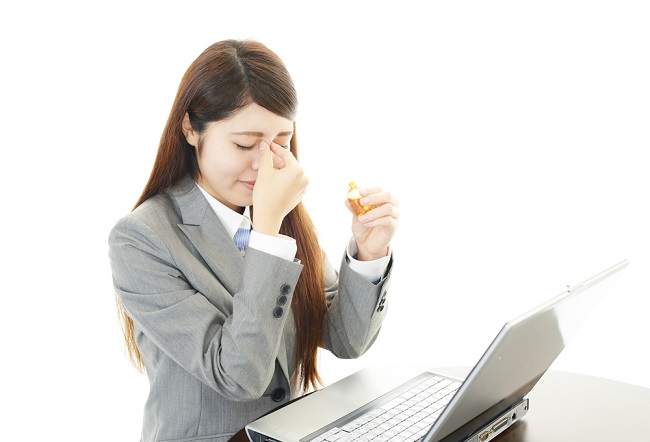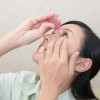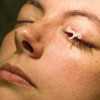Air mata buatan (artificial tears) biasa diresepkan untuk pasien sindrom mata kering, apakah literatur medis mendukung praktik umum ini? Sindrom mata kering atau dry eye syndrome (DES) terjadi karena adanya gangguan pada lapisan air mata dengan penyebab yang multifaktorial, merupakan kelainan mata yang sering ditemukan dengan prevalensi 5,5−33,7% pada populasi dunia.[1-4]
Tetes air mata buatan menjadi pilihan untuk penanganan DES. Selain itu, obat tetes mata ini juga dapat berperan dalam abrasi kornea dan penyembuhan luka, penanganan nyeri dan peradangan, konjungtivitis, keratitis, pembasahan dan pelepasan lensa kontak, serta pengangkatan benda asing.[5]
Sekilas Tentang Sindrom Mata Kering
Prevalensi kejadian dry eye syndrome (DES) meningkat bila disertai beberapa faktor risiko, seperti usia di atas 50 tahun, jenis kelamin wanita, dakrioadenitis, gangguan neurotropik, dan disfungsi kelenjar meibom.[1-4]
Diagnosis DES kering dan klasifikasi gangguan ditegakkan melalui anamnesis, pemeriksaan fisik, dan penunjang. Pemeriksaan penunjang yang umumnya baik secara subjektif seperti kuesioner Ocular Surface Disease Index (OSDI), System for Patient Evaluation of Eye Dryness (SPEED), Symptom Assessment in Dry Eye (SANDE), dan The Dry Eye Questionnaire.
Sementara itu, pemeriksaan penunjang secara objektif di antaranya tes Schirmer, pengukuran tear film break-up time (TBUT), pewarnaan kornea dengan fluoresin, test matrix metalloproteinase-9 (MMP-9), dan pemeriksaan serum biomarker.[8,10-12]
Medikamentosa untuk Sindrom Mata Kering
Beberapa pilihan terapi medikamentosa terus dikembangkan sesuai dengan mekanisme patofisiologi DES. Pilihan utama adalah dengan pemberian tetes air mata buatan. Beberapa pilihan lain adalah pemberian kortikosteroid topikal atau siklosporin A topikal untuk menekan peradangan.
Pilihan lain adalah aplikasi serum autolog tetes mata. Serum ini memiliki kelebihan untuk memicu proliferasi dan migrasi sel epitel yang lebih baik, serta memberikan nutrisi biokimia optimal pada permukaan mata. Namun, penggunaannya masih terbatas untuk tujuan penelitian dan masih terus dikembangkan. Sampai saat ini, pilihan utama untuk terapi DES adalah pemberian tetes air mata buatan sebagai obat yang dapat dibeli bebas di masyarakat (over the counter / OTC).[10-13]
Tetes Air Mata Buatan untuk Sindrom Mata Kering
Air mata buatan untuk DES bertujuan untuk menggantikan volume air mata, menstabilisasi lapisan air mata, melindungi sel epitel okular, dan mengurangi kemungkinan gesekan saat gerakan mengedip. Banyak jenis air mata buatan yang dijual bebas, dengan berbagai variasi komposisi, osmolaritas, pH, serta pengawet yang digunakan.[2,8,11,12]
Penelitian oleh Tong et al pada tahun 2012 menyimpulkan bawah pemilihan obat tetes air mata buatan tergantung pada kondisi pasien DES. Pada DES kondisi berat atau pada penggunaan obat tetes dengan frekuensi lebih jarang, akan membutuhkan lubrikan yang lebih viskos.[14]
Viskositas kandungan air mata buatan sebaiknya dipilih dalam kondisi seimbang. Viskositas yang terlalu rendah akan mengurangi waktu retensi, sehingga perlu sering diaplikasikan. Sedangkan viskositas yang terlalu tinggi menyebabkan kristalisasi sediaan pada daerah kelopak mata atau bulu mata, sehingga mengakibatkan gejala pandangan kabur. Kandungan air mata yang mempengaruhi keseimbangan viskositas air mata adalah hydrogel.[14]
Pengawet sebaiknya bukan benzalkonium chloride (BAK) dan chlorobutanol karena memiliki efek samping merusak kornea. Jika tidak ada pilihan lain maka penggunaannya harus dibatasi untuk menghindari efek samping. Apabila dipilih air mata buatan dengan sediaan tanpa pengawet, maka hanya dapat digunakan 24 jam setelah dibuka karena berisiko terkontaminasi oleh mikroorganisme.[14]
Penelitian Pemberian Tetes Air Mata Buatan untuk Sindrom Mata Kering
Penelitian mengenai komposisi dari air mata buatan cukup banyak dilakukan, dengan menggunakan berbagai macam kandungan tetes air mata buatan.
Kandungan Propylene Glycol Based (PG)
Penelitian oleh Aguilar et al tahun 2014 membandingkan pemberian tetes air mata buatan dengan pemberian larutan saline pada 49 pasien DES. Obat tetes mata yang diteliti mengandung propylene glycol 0.6%, hydroxypropyl-guar, borate, sorbitol, dimyristoyl phosphatidylglycerol, and mineral oil. Hasil penelitian adalah perbaikan TBUT dan kualitas air mata meningkat secara signifikan pada minggu ke-4 pada kelompok yang diberikan tetes air mata buatan.[15]
Kandungan Polyethylene Glycol (PEG) dan Hydroxypropyl Methylcellulose (HPMC)
Penelitian Comez et al tahun 2013 membandingkan dua air mata buatan dengan kandungan yang berbeda pada 22 pasien dengan DES. Tetes air mata buatan tersebut adalah polyethylene glycol (PEG) ditambah propylene glycol (PG) atau sodium hyaluronate, dibandingkan dengan hydroxypropyl methylcellulose (HPMC) ditambah carboxymethylcellulose (CMC) sodium. Hasil penelitian didapatkan perbaikan signifikan pada kedua kelompok, dan tidak ada perbedaan bermakna saat dibandingkan antar kelompok.[16]
Kandungan Carboxymethylcellulose (CMC) Sodium
Berdasarkan penelitian berkelanjutan oleh Simmons et al didapatkan bahwa CMC 1% memiliki efek perbaikan yang lebih baik tetapi ditemukan efek samping. Sedangkan sediaan dengan pengawet aquos memiliki efek samping yang lebih sedikit. Penelitian ini menyimpulkan bahwa pemilihan tetes air mata buatan sebaiknya mempertimbangkan manfaat dan risiko yang hendak dicapai, serta bergantung pada kondisi masing-masing pasien.[17,18]
Meta Analisis Obat Tetes Mata Dijual Bebas
Studi systematic review oleh Pucker et al, tahun 2016, mengevaluasi efektivitas dan keamanan penggunaan tetes air mata buatan OTC dalam pengobatan DES. Studi ini menganalisa 43 penelitian dengan total 3497 subjek yang diamati selama 1 minggu hingga 3 bulan.[19]
Hasil studi memperlihatkan bahwa terdapat banyak jenis komposisi dan sediaan air mata buatan OTC yang digunakan di masyarakat. Pada masing-masing penelitian dengan jenis tetes mata yang berbeda memberikan efektivitas perbaikan gejala okular dari pasien DES yang bervariasi, namun secara umum seluruhnya memberikan perbaikan yang konsisten.[19]
Umumnya, hasil penelitian menunjukkan penggunaan tetes air mata buatan aman. Efek samping yang kadang ditimbulkan tergolong ringan, yaitu pandangan kabur dan rasa seperti sensasi benda asing.[18]
Tinjauan sistematis tahun 2023 menganalisis 64 uji coba terkontrol secara acak yang membandingkan efikasi air mata buatan pada pasien DES. Hasil tinjauan menunjukkan bukti yang signifikan bahwa air mata buatan dapat memperbaiki gejala DES dalam waktu 1 bulan setelah penggunaan rutin, dan diterapkan sekitar 4 kali sehari. Namun, tanda DES biasanya membutuhkan waktu beberapa bulan untuk membaik.[5]
Tidak semua pasien DES mendapat manfaat dari air mata buatan, sehingga pengobatan alternatif harus dipertimbangkan jika pemberian air mata buatan tidak menunjukkan manfaat setelah digunakan rutin selama sebulan.[5]
Penatalaksanaan Sindrom Mata Kering di Indonesia
Pilihan terapi DES di Indonesia, berdasarkan perhimpunan Dokter Spesialis Mata Indonesia, mengadopsi konsep yang dikembangkan oleh Asian Dry Eye Society. Tata laksana sesuai dengan klasifikasi etiopatologi yang bertujuan memperbaiki gejala dan meningkatkan kualitas hidup.[8]
Terapi yang disarankan adalah sediaan bebas zat pengawet, hipotonik atau isotonik, mengandung elektrolit, pH netral atau sedikit basa, dan osmolaritas 181−354 mOsm/L. Pengawet benzalkonium chloride (BAK) harus dihindari karena memiliki efek samping merusak epitel kornea dan konjungtiva.[7,8]
Beberapa kandungan tetes air mata yang tersedia di Indonesia adalah:
- Kandungan hydroxypropyl cellulose, cellulose dan polyvinyl, serta chondroitin sulphate dan sodium hyaluronat memiliki peran sebagai lubrikasi yang bersifat steril dan menjaga viskositas lapisan air mata
- Kandungan diquafosol atau rebamipide memiliki efek menstimulasi sekresi air dan lipid dengan menstimulasi sel mucin 1, mucin 4, dan mucin 16.
- Kandungan cyclosporine sebagai antiinflamasi dapat digunakan untuk mengurangi proses peradangan pada sindrom mata kering [20,21]
Selain tata laksana medikamentosa, penting untuk dilakukan tata laksana nonfarmakologi berupa edukasi menghindari paparan faktor risiko, menjaga kelembaban lingkungan, serta mengonsumsi nutrisi optimal khususnya vitamin A dan asam lemak omega 3. Defisiensi vitamin A dapat mempengaruhi sel saraf mata, sedangkan asam lemak omega 3 dapat menghambat produksi IL-1 dan TNF alfa sebagai agen inflamatorik. Beberapa studi juga telah mempelajari peran vitamin D dalam manajemen dry eye syndrome.[8,12]
Cara pemakaian tetes air mata buatan adalah dengan diteteskan langsung pada mata dengan dosis yang sesuai. Pasien harus diingatkan untuk menjaga kebersihan dan kesterilan obat tetes mata, yaitu cuci tangan sebelum dan sesudah penggunaan, jangan biarkan botol tetes mata menyentuh kulit atau mata, simpan sesuai petunjuk, dan buang setelah digunakan selambat-lambatnya 4 minggu sejak dibuka.[20,21]
Kesimpulan
Sindrom mata kering atau dry eye syndrome (DES) merupakan kondisi kelainan mata yang sering dialami populasi umum. Etiologi kondisi ini bersifat multifaktorial, sehingga memerlukan tata laksana secara komprehensif. Dimulai dari pembatasan faktor risiko, pemberian nutrisi optimal, pembatasan paparan cahaya alat elektronik sehari-hari, serta pemberian tetes air mata buatan.
Penggunaan tetes air mata buatan menjadi salah satu pilihan medikamentosa pasien DES, khususnya bila pasien sudah merasakan gejala 4‒6 kali dalam sehari. Tetes air mata buatan dapat dihentikan bila gejala sudah menghilang (biasanya dalam waktu 1 bulan), atau pemeriksaan klinis sudah menunjukkan perbaikan secara objektif (membutuhkan waktu beberapa bulan).
Studi menunjukkan bahwa tidak semua pasien DES mendapat manfaat dari air mata buatan. Pengobatan lain perlu dipertimbangkan jika pemberian air mata buatan tidak menunjukkan manfaat setelah digunakan rutin selama sebulan.
Tetes air mata buatan bermanfaat untuk menggantikan volume air mata, menstabilkan lapisan air mata, melindungi sel epitel okular, dan mengurangi kemungkinan gesekan saat mata mengedip. Namun, Namun, bukti yang ada mengenai tetes air mata buatan OTC masih buruk dan banyak penelitian terdaftar yang tidak dipublikasikan. Oleh karena itu, studi besar lebih lanjut dengan desain yang kuat diperlukan untuk memahami manfaat penggunaan air mata buatan dan mendapatkan kandungan terbaik.
Direvisi oleh: dr. Hudiyati Agustini
















